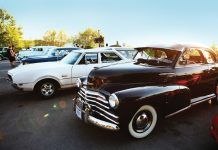Humans are inventive. Often dissatisfied with the limitations of their reach, people have imagined and created tools to extend their grasp, even long ago in the times before recorded history. The Barona Cultural Center & Museum brought back to life some of the ancient arts of the Kumeyaay-Diegueño tribes for making hunting tools, with a class on techniques for crafting spears and atlatls, which are spear throwers.
Humans are inventive. Often dissatisfied with the limitations of their reach, people have imagined and created tools to extend their grasp, even long ago in the times before recorded history. The Barona Cultural Center & Museum brought back to life some of the ancient arts of the Kumeyaay-Diegueño tribes for making hunting tools, with a class on techniques for crafting spears and atlatls, which are spear throwers.
Willie Pink led the five-hour session at the museum on Saturday, February 6. The class was free of charge to Barona tribal members and open to the public for a $25 fee.
Pink described the overall background of spears and atlatls, with the throwers using the principle of leverage to increase the distance and power of a spear’s trajectory toward its target. He informed the nine class attendees that the atlatl was the predecessor of the bow and arrow. Atlatls spread worldwide as tools and are still in use in Australia by aborigines. Moreover, the hunting implements commonly available affected migration and settlement patterns for native people.
The class also involved learning practical skills, with each participant taught hands-on techniques for making an atlatl and a spear. In a nod to the limitations of a one-day course of instruction, Pink assisted his students by speeding the first stages of the process with power tools, shaping each student’s curved piece of wood and drilling an angled aperture to hold the atlatl’s spear hook. The attendees then took over with hand knives and woodworking tools to smooth the edges and round out the handles. “Work it slow,” Pink advised. An early method introduced to cut the tool-making time was burning the wood then scraping off the ash.
The hook for launching the spear off the atlatl was made from a piece of antler. Native people used obsidian blades to easily cut off antler tips, Pink said. And although the earlier atlatl makers used pine resin and clay to fix the antler tip hook into the atlatl, Pink mixed red earth paint powder into modern epoxy to simulate the look of the ancient weapon in attaching each student’s hook.
Under original conditions as a traditional skill, atlatl making would take a couple of days, Pink explained. “This will last you a lifetime,” Pink said in encouraging class members to take time and care in crafting their atlatls.
The course was one in a monthly series offered in the “Ancient Spirits Speak” program of the Barona Cultural Center & Museum, according to the museum’s education coordinator, Mallory Genauer. Eight months of the year, with summers off, the museum presents a class teaching participants a different traditional skill of the Kumeyaay- Diegueño tribes. Genauer said that the courses draw “a good mix” from tribal members and interested people from the general public. Genauer observed that college students and retirees have found the classes “very popular” for learning the traditional skills that are taught.
The museum has offered these educational courses since opening in 2001, as the first such center on a tribal reservation. Willie Pink has been a course instructor in the series for over 10 years.
“These classes have been provided as a gift to the people of the county,” Genauer said. “The purpose is to preserve the cultural history and traditional skills of the people who lived here before. Theirs was not a primitive society at all. Their tools were complex, and they had a rich culture. We want to educate people today about how they lived and took care of this land.”
The March class will focus on preparation of native foods, especially recipes incorporating yucca. Other upcoming courses will teach juncus-reed basket making and agave-fiber sandal making. Fall classes will resume after a summer break. Subjects also covered in the “Ancient Spirits Speak” series include making projective points, making bows and forming clay pottery pieces.
The Barona Cultural Center & Museum can be visited in Lakeside at 1095 Barona Road. The museum is open Tuesday through Friday, 12 p.m. to 5 p.m., and on Saturdays, 10 a.m. to 4 p.m. Announcements of the classes are provided to tribal members and interested persons who are on the museum’s mail and email lists. The courses are also announced on the San Diego Museum Council’s website. Further information is available by phone at (619) 443-7003 or online at www.baronamuseum.org.














